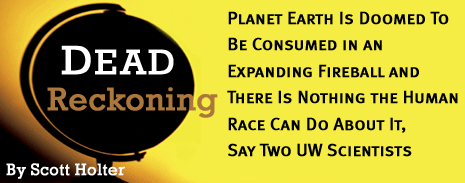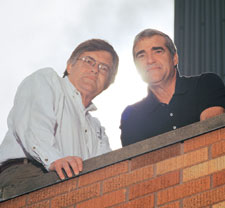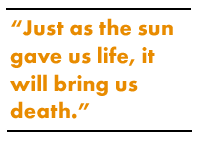
The world will come to an end at 12 o'clock. And it's already 4:30 ...
... But before you dust off the Y2K bunker or dash for the duct tape, please be aware that not a person reading this article, or anyone currently alive anywhere on the planet, will be around to witness the Earth's expiration. You see, this clock is measured not in minutes but in years, and not in single years—or decades, centuries, even millenniums—but in billions of years.
That's four-and-a-half billion down, seven-and-a-half billion to go.
The math is straightforward; it's the science that's a bit drawn-out, according to UW Astronomy Professor Donald Brownlee. As that enormous ball of hydrogen we call the sun gets older, it also gets bigger and hotter and brighter-it is 30 percent brighter now than on the day Earth was formed. By the completion of the sun's projected 12-billion-year life cycle, it will have evaporated our oceans, degraded our atmosphere and, in one final act, charred the Earth to its core, eradicating it, melting it and sending every last molecule shooting into space.

UW Professors Donald Brownlee (left) and Peter Ward have written a new book on The Life and Death of Planet Earth. Photo by Joel Levin.
"People really should have an understanding of the fate that lies ahead," says Brownlee, seated in his information-scattered office on the UW campus. "In 7.5 billion years Earth will either be swallowed up or survive only as a scorched planet. Most of us know the Earth is not flat. Most of us know it is not the center of the universe. But not many of us know that the sun won't last forever. And we should, because just as it gave us life, it will bring us death."
Brownlee and Peter Ward, a UW professor of Earth and space sciences and also of zoology, present the end-of-the-world thesis in their most recent book, The Life and Death of Planet Earth. The co-authors offer 213 pages of data that are equal parts biography and history, chronicling the planet's first 4.5 billion years and providing scenarios for what may happen during what they call "the second half of life on Earth."
"The dates can be criticized because saying exactly when is difficult," says Ward, hours after returning from a New York City book-signing. "What we provide is not new research by us. It's simply presenting a compilation of scientific literature."
Brownlee and Ward write: "We know that our planet is approximately 4.5 billion years old and that life is at least 3.4 billion years old. … We can predict that the last animals on this planet will die out as early as 500 million years from now."
 It will not be an expeditious death, analogous instead to the aging process of most human beings. Earth will lose one life-sustaining system after another-fuel, ice, oceans, plants and animals-until it meets its ultimate demise. The authors theorize that the existence of animals and plants is extraordinarily stunted on the Earth's watch, beginning at 4 o'clock and ending right around 5.
It will not be an expeditious death, analogous instead to the aging process of most human beings. Earth will lose one life-sustaining system after another-fuel, ice, oceans, plants and animals-until it meets its ultimate demise. The authors theorize that the existence of animals and plants is extraordinarily stunted on the Earth's watch, beginning at 4 o'clock and ending right around 5.
"Most animals go extinct in a couple of million years," Brownlee says. "No one has any idea of what it would take to totally drive the human race to extinction. I'm optimistic that we could be among the last survivors on the planet because we are adaptable. It may become too hot for large animals, but people could adapt somehow."
Astronomer Brownlee is well-versed in the universe's "other" worlds, while paleontologist Ward's expertise is on that which has already ended: dinosaurs, fossils and rocks. To establish Earth's fate, they relied on astrobiology, a fusion of biology, astronomy and paleontology, complementing our planet's evolution with the life and history of other planets. By examining the Earth's evolution, they conclude that only microscopic and bacterial organisms existed during Earth's initial four billion years. They surmise that our planet's biodiversity peaked as long as 300 million years ago.
"At one time the Earth was covered by ocean," Brownlee says. "But land became important in that it plays a key role in the cycles that control the temperature. Much of the land mass in the world 250 million years ago was connected as a single continent. The continents today are basically bouncing around. The future Earth will go back to things of the past, and 250 million years from now the continents will have gone back to one another." One result of this continental drift, Brownlee and Ward write, "may cause a mass extinction that kills off the majority of species on the planet."
Go To: Page 1 | Page 2 | Page 3
Sidebar: Seeking Life on Other Worlds
- Return to September 2003 Table of Contents